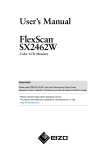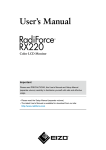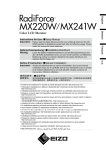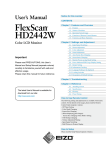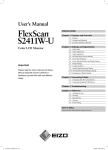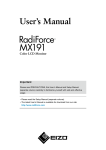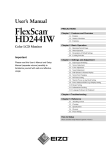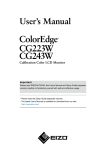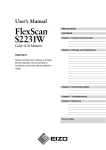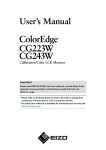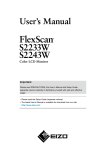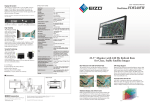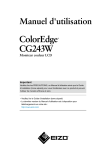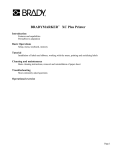Download RadiForce MX241W User`s Manual
Transcript
Important Please read this User’s Manual and Setup Manual (separate volume) carefully to familiarize yourself with safe and effective usage. • Please read the Setup Manual (separate volume) • The latest User’s Manual is available for download from our site: http://www.radiforce.com SAFETY SYMBOLS This manual uses the safety symbols below. They denote critical information. Please read them carefully. WARNING Failure to abide by the information in a WARNING may result in serious injury and can be life threatening. CAUTION Failure to abide by the information in a CAUTION may result in moderate injury and/or property or product damage. Indicates a prohibited action. Indicates to ground for safety. Product specification may vary with sales areas. Confirm the specification in the manual written in language of the region of purchase. • It shall be assured that the final system is in compliance to IEC60601-1-1 requirement. • Power supplied equipment can emit electromagnetic waves, that could influence, limit or result in malfunction of the monitor. Install the equipment in a controlled environment, where such effects are avoided. • This is a monitor intended for use in a medical image system. It does not support the display of mammography images for diagnosis. Copyright© 2009 EIZO NANAO CORPORATION All rights reserved. No part of this manual may be reproduced, stored in a retrieval system, or transmitted, in any form or by any means, electronic, mechanical, or otherwise, without the prior written permission of EIZO NANAO CORPORATION. EIZO NANAO CORPORATION is under no obligation to hold any submitted material or information confidential unless prior arrangements are made pursuant to EIZO NANAO CORPORATION’s receipt of said information. Although every effort has been made to ensure that this manual provides up-to-date information, please note that EIZO monitor specifications are subject to change without notice. Apple and Macintosh are registered trademarks of Apple Inc. VGA is a registered trademark of International Business Machines Corporation. Windows and Windows Vista are registered trademarks of Microsoft Corporation. The round gothic bold bit map font used for this product is designed by Ricoh. DisplayPort icon and VESA are trademarks and registered trademarks of Video Electronics Standards Association. PowerManager is a trademark of EIZO NANAO CORPORATION. EIZO, RadiCS, RadiForce, RadiNET and ScreenManager are registered trademarks of EIZO NANAO CORPORATION in Japan and other countries. PRECAUTIONS IMPORTANT! • This product has been adjusted specifically for use in the region to which it was originally shipped. If operated outside the region to which it was originally shipped, the product may not perform as stated in the specifications. • To ensure personal safety and proper maintenance, please read this section and the caution statements on the unit (refer to the figure below). ● Location of the Caution Statements ● Symbols on the unit Symbol This symbol indicates Main Power Switch Press to turn the monitor’s main power off Main Power Switch Press to turn the monitor’s main power on. Power Button Press to turn the monitor’s power on or off. Alternating current Alerting electrical hazard Caution Refer to SAFETY SYMBOLS section in this manual. PRECAUTIONS WARNING If the unit begins to emit smoke, smells like something is burning, or makes strange noises, disconnect all power connections immediately and contact your dealer for advice. Attempting to use a malfunctioning unit may result in fire, electric shock, or equipment damage. Do not open the cabinet or modify the unit. Opening the cabinet or modifying the unit may result in fire, electric shock, or burn. Refer all servicing to qualified service personnel. Do not attempt to service this product yourself as opening or removing covers may result in fire, electric shock, or equipment damage. Keep small objects or liquids away from the unit. Small objects accidentally falling through the ventilation slots into the cabinet or spillage into the cabinet may result in fire, electric shock, or equipment damage. If an object or liquid falls/spills into the cabinet, unplug the unit immediately. Have the unit checked by a qualified service engineer before using it again. Place the unit at the strong and stable place. A unit placed on an inadequate surface may fall and result in injury or equipment damage. If the unit falls, disconnect the power immediately and ask your dealer for advice. Do not continue using a damaged unit. Using a damaged unit may result in fire or electric shock. Set the unit in an appropriate location. Not doing so may result in fire, electric shock, or equipment damage. • Do not place outdoors. • Do not place in the transportation system (ship, aircraft, trains, automobiles, etc.) • Do not place in a dusty or humid environment. • Do not place in a location where water is splashed on the screen (bathroom, kitchen, etc.). • Do not place in a location where the steam comes directly on the screen. • Do not place near heat generating devices or a humidifier. • Do not place in an inflammable gas environment. To avoid danger of suffocation, keep the plastic packing bags away from babies and children. Use the enclosed power cord and connect to the standard power outlet of your country. Be sure to remain within the rated voltage of the power cord. Not doing so may result in fire or electric shock. Power supply: 100-120/200-240 Vac, 50/60 Hz To disconnect the power cord, grasp the plug firmly and pull. Tugging on the cord may damage and result in fire or electric shock. PRECAUTIONS OK WARNING The equipment must be connected to a grounded main outlet. Not doing so may cause in fire or electric shock. Use the correct voltage. • The unit is designed for use with a specific voltage only. Connection to another voltage than specified in this User’s Manual may cause fire, electric shock, or equipment damage. Power supply: 100-120/200-240 Vac, 50/60 Hz • Do not overload your power circuit, as this may result in fire or electric shock. Handle the power cord with care. • Do not place the cord underneath the unit or other heavy objects. • Do not pull on or tie the cord. If the power cord becomes damaged, stop using it. Use of a damaged cord may result in fire or electric shock. For the electrical safety, do not connect or disconnect the power cord in the presence of patients. Never touch the plug and power cord if it begins to thunder. Touching them may result in electric shock. When attaching an arm stand, please refer to the user’s manual of the arm stand and install the unit securely. Not doing so may cause the unit to come unattached, which may result in injury or equipment damage. When the unit is dropped, please ask your dealer for advice. Do not continue using a damaged unit. Using a damaged unit may result in fire or electric shock. When reattaching the tilt stand, please use the same screws and tighten them securely. Do not touch a damaged LCD panel directly with bare hands. The liquid crystal which leaks from the panel is poisonous if it enters the eyes or mouth. If any part of the skin or body comes in direct contact with the panel, please wash thoroughly. If some physical symptoms result, please consult your doctor. Fluorescent backlight lamps contain mercury (the products that have LED backlight lamps contain no mercury), dispose according to local, state or federal laws. PRECAUTIONS CAUTION Handle with care when carrying the unit. Disconnect the power cord and cables when moving the unit. Moving the unit with the cord attached is dangerous. It may result in injury. When handling the unit, grip the bottom of the unit firmly with both hands ensuring the panel faces outward before lifting. Dropping the unit may result in injury or equipment damage. Do not block the ventilation slots on the cabinet. • Do not place any objects on the ventilation slots. • Do not install the unit in a closed space. • Do not use the unit laid down or upside down. Blocking the ventilation slots prevents proper airflow and may result in fire, electric shock, or equipment damage. Do not touch the plug with wet hands. Doing so may result in electrical shock. Use an easily accessible power outlet. This will ensure that you can disconnect the power quickly in case of a problem. Periodically clean the area around the plug. Dust, water, or oil on the plug may result in fire. Unplug the unit before cleaning it. Cleaning the unit while it is plugged into a power outlet may result in electric shock. If you plan to leave the unit unused for an extended period, disconnect the power cord from the wall socket after turning off the power switch for the safety and the power conservation. PRECAUTIONS Notice for this monitor This product is suited to clinical review. It does not support the display of mammography images for diagnosis. This product has been adjusted specifically for use in the region to which it was originally shipped. If the product is used outside the region, it may not operate as specified in the specifications. This product may not be covered by warranty for uses other than those described in this manual. The specifications noted in this manual are only applicable for power cords and signal cables specified by us. Use optional products manufactured or specified by us with this product. As it takes about 30 minutes for the performance of electrical parts to stabilize, adjust the monitor 30 minutes or more after the monitor power has been turned on. In order to suppress the luminosity change by long-term use and to maintain the stable luminosity, use of a monitor in lower brightness is recommended. When the screen image is changed after displaying the same image for extended periods of time, an afterimage may appear. Use the screen saver or timer to avoid displaying the same image for extended periods of time. Periodic cleaning is recommended to keep the monitor looking new and to prolong its operation lifetime. (Refer to “Cleaning” on the next page.) The screen may have defective pixels. These pixels may appear as slightly light or dark area on the screen. This is due to the characteristics of the panel itself, and not the product. The backlight of the LCD panel has a fixed life span. When the screen becomes dark or begins to flicker, please contact your dealer. Do not press on the panel or edge of the frame strongly, as this may result in the display malfunction, such as the interference patterns, etc. If pressure is continually applied to the LCD panel, it may deteriorate or damage your LCD panel. (If the pressure marks remain on the LCD panel, leave the monitor with a white or black screen. The symptom may disappear.) Do not scratch or press on the panel with any sharp objects, such as a pencil or pen as this may result in damage to the panel. Do not attempt to brush with tissues as this may scratch the LCD panel. When the monitor is cold and brought into a room or the room temperature goes up quickly, dew condensation may occur inside and outside the monitor. In that case, do not turn the monitor on and wait until dew condensation disappears, otherwise it may cause some damages to the monitor. PRECAUTIONS Cleaning Attention • Never use any solvents or chemicals, such as thinner, benzene, wax, alcohol, disinfectant, and abrasive cleaner, which may damage the cabinet or LCD panel. NOTE • Optional ScreenCleaner is recommended for cleaning the panel surface. ● LCD Panel • Clean the LCD panel with a soft cloth such as cotton cloth or lens cleaning paper. • Remove persistent stains gently with a cloth dampened with a little water, and then clean the LCD panel again with a dry cloth for better finishing. ● Cabinet • Clean the cabinet with a soft cloth dampened with a little mild detergent. To use the monitor comfortably • An excessively dark or bright screen may affect your eyes. Adjust the brightness of the monitor according to the environmental conditions. • Staring at the monitor for a long time tires your eyes. Take a 10-minute rest every hour. PRECAUTIONS CONTENTS Cover . ............................................................ 1 Chapter 3 Setting Monitor................................. 25 PRECAUTIONS...................................................... 3 3-1. Enabling/Disabling Mode Selection [Mode Preset].................................................. 25 Notice for this monitor.............................................. 7 CONTENTS.............................................................. 9 Chapter 1 Introduction...................................... 10 1-1. Features............................................................10 3-2. Locking Buttons [Key Lock]......................... 25 3-3. Setting the EIZO Logo Display [Logo]......... 26 3-4. Setting Orientation [Orientation]................. 26 ●To set the orientation of the Adjustment 1-2. Controls and Functions..................................11 menu................................................................. 26 1-3. Utility Disk........................................................11 3-5. Setting Language [Language]...................... 26 ●Disk contents and software overview................11 ●To RadiCS LE or ScreenManager Pro 3-6. Setting the Display Position of the Adjustment Menu [Menu Position]............... 27 for Medical.........................................................11 1- 4. Basic Operation and Functions.....................12 Basic operation of Adjustment menu.................12 Functions...............................................................13 Chapter 2 Adjusting Screen.............................. 14 3-7. Restoring the Default Setting....................... 27 ●To reset color adjustment values [Color Reset]..................................................... 27 ●To reset all adjustments to the factory default settings [All Reset]............................................ 27 Chapter 4 Power Saving Function.................... 28 2-1. Setting Screen Resolution................................14 Compatible Resolutions/Frequencies................14 Setting Resolution................................................14 ●Windows Vista...................................................14 ●Windows XP.......................................................14 ●Mac OS X...........................................................14 2-2. Displaying Screen Correctly..........................15 4-1. Setting the Power Saving [Power Save]...... 28 4-2. Setting Power Indicator [Power Indicator]............................................ 28 4-3. Setting Monitor’s Automatic Brightness Adjustment [Auto EcoView].......................... 29 Chapter 5 Troubleshooting............................... 30 Digital Input...........................................................15 Chapter 6 Reference.......................................... 33 Analog Input..........................................................15 6-1. Attaching an Arm........................................... 33 2-3. Color Adjustment............................................19 6-2. Connecting More than Two PCs to the Monitor............................................................ 34 ●To select the display mode (CAL Switch)..........19 ●To perform advanced adjustments....................19 ●Adjustment items in each mode........................ 20 ●To adjust the brightness [Brightness].................21 ●To adjust the contrast [Contrast]........................21 ●To adjust the color temperature [Temperature].....................................................21 ●To adjust the gamma value [Gamma]............... 22 ●To adjust the hue [Hue]..................................... 22 ●To adjust the color saturation [Saturation]........ 22 ●To enhance the outline of the image [Outline Enhancer].......................................................... 23 ●To switch the input signal.................................. 34 ●To set input signal selection [Input Signal]........ 35 6-3. Making Use of USB (Universal Serial Bus).................................... 36 ●Required System Environment......................... 36 ●Connection Procedure (Setup of USB Function)................................... 36 6-4. Displaying Monitor Information....................37 ●Displaying monitor information by pressing . .......................................................37 ●Displaying signal information [Signal Info].........37 ●Displaying monitor information [Monitor Info]....37 ● ●To adjust six colors [6 Colors]........................... 23 6-5. Specifications................................................. 38 2-4. Displaying Lower Resolutions...................... 24 6-6. Glossary.......................................................... 42 ●To change screen size [Screen Size].................24 6-7. Preset Timing.................................................. 44 To adjust the gain value [Gain].......................... 23 FCC Declaration of Conformity.......................... 45 EMC Information.................................................. 46 CONTENTS Chapter 1 Introduction Thank you very much for choosing an EIZO Color Monitor. 1-1. Features • • • • • 24” wide format LCD Applicable to the resolution 1920 dots x 1200 lines Applicable to DisplayPort (applicable to 8 bit or 10 bit, not applicable to audio signals) 3 signal input terminals (DVI-I x 2, DisplayPort x 1) CAL Switch function for selecting an optimal calibration mode “2-3. To select the display mode (CAL Switch)” (page 19) • DICOM mode (CAL Switch function) (page 42) • The quality control software “RadiCS LE” (for Windows) used to calibrate the monitor is included “1-3. Utility Disk” (page 11) • The software “ScreenManager Pro for Medical” (for Windows) to adjust the screen using the mouse and keyboard is included “1-3. Utility Disk” (page 11) • Frame Synchronous mode supported (59 - 61 Hz) • Power saving function This product is equipped with power saving function. - Power Consumption when main power switch is Off: 0W Equipped with main power switch. Turning off the main power switch completely shuts off power supply to the monitor while the monitor is not used. - Auto EcoView function The sensor on the front side of the monitor detects the environmental brightness to adjust the screen brightness automatically and comfortably. Excessively high brightness may lead a damage to the natural environment as well as to your eyes. Suppressing the excessively high brightness will be helpful to reduce the power consumption and the damage to your eyes. “4-3. Setting Monitor’s Automatic Brightness Adjustment [Auto EcoView]” (page 29) • HDCP (High-bandwidth Digital Content Interface) • Portrait/Landscape display available (rotate 90 degrees clockwise) NOTE • This monitor supports the Portrait/Landscape display. This function allows you to change the orientation of the Adjustment menu when using the monitor screen in vertical display position. (Refer to “To set the orientation of the Adjustment menu [Orientation]” on page 26.) • For using the monitor with “Portrait” position, the graphics board supporting portrait display is required. When using the monitor with “Portrait” position, the setting needs to be changed depending on the graphics board used in your PC. Refer to the manual of the graphics board for details. 10 Chapter 1 Introduction 1-2. Controls and Functions Adjustment menu Operation buttons 1 2 3 4 1. Sensor (AutoEcoView) 2. button 3. button 4. button 5. button Indicator status 5 6 7 8 9 10 6. button 7. button 8. button 9. button 10. Power Indicator Operation status Blue The screen is displayed Orange Power saving Off Main Power Switch / Power button off 1-3. Utility Disk An “EIZO LCD Utility Disk” (CD-ROM) is supplied with the monitor. The following table shows the disk contents and the overview of the software programs. ● Disk contents and software overview The disk includes application software programs for adjustment, and User’s Manual. Refer to “Readme. txt” file on the disk for software startup procedures or file access procedures. Item Overview A “Readme.txt” file RadiCS LE (for Windows) RadiCS LE is quality control software used to calibrate the monitor and manage the calibration history. (A PC must be connected to the monitor with the supplied USB cable.) Refer to the description later. ScreenManager Pro for Medical (for Windows) A utility software program to control monitor adjustments from a PC using its mouse and keyboard. (A PC must be connected to the monitor with the supplied USB cable.) Refer to the description later. User’s Manual (PDF file) ● To RadiCS LE or ScreenManager Pro for Medical Refer to the corresponding User’s Manual on the CD-ROM disk in order to install and use the software. When using this software, you will need to connect a PC to the monitor with the supplied USB cable. For more information refer to the “6-3. Making Use of USB (Universal Serial Bus)” (page 36). Chapter 1 Introduction 11 1- 4. Basic Operation and Functions Basic operation of Adjustment menu 1 Displaying Adjustment Menu Press . The adjustment menu appears. Menu title Current mode Item Settings Menu 2 Adjusting/Setting 1. Choose a menu to adjust/set with , and press . 2. Choose an item to adjust/set with , and press . 3. Adjust/set the selected item with , and press 3 Exiting Press a few times. The adjustment menu finishes. 12 Chapter 1 Introduction . Functions The following table shows all the Adjustment menu’s adjustment and setting menus. Main Menu Color Item Adjusting/Setting “2-3. Color Adjustment” (page 19) Brightness Contrast Temperature Gamma Advanced Settings Hue Saturation Outline Enhancer Gain 6 Colors “3-7. Restoring the Default Setting” (page 27) Color Reset Screen Screen Size Analog Adjustment Auto Adjustment Range Adjustment “2-4. Displaying Lower Resolutions” (page 24) “2-2. Displaying Screen Correctly” (page 15) Clock Phase Hor.Position Ver.Position PowerManager Power Save Power Indicator “4-3. Setting Monitor’s Automatic Brightness Adjustment” (page 29) “4-2. Setting Power Indicator” (page 28) Language “3-5. Setting Language” (page 26) Orientation “3-4. Setting Orientation” (page 26) Menu Position “3-6. Setting the Display Position of the Adjustment Menu” (page 27) Auto EcoView Menu Settings Tools “4-1. Setting the Power Saving” (page 28) Input Selection Mode Preset Signal Info “6-2. Connecting More than Two PCs to the Monitor” (page 34) “3-1. Enabling/Disabling Mode Selection” (page 25) “6-4. Displaying Monitor Information” (page 37) Monitor Info All Reset “3-7. Restoring the Default Setting” (page 27) * The adjusting/setting function on the <Color> menu depend on the selected Color mode (page 20). The above table shows the sub menus when the “Custom” mode is selected (See “2-3. Color Adjustment” (page 19)). Chapter 1 Introduction 13 Chapter 2 Adjusting Screen 2-1. Setting Screen Resolution Compatible Resolutions/Frequencies For details on compatible resolutions, refer to “Compatible Resolutions/Frequencies” in the Setup Manual. Setting Resolution When you connect the monitor to the PC and find that the resolution is improper, or when you want to change the resolution, follow the procedure below. ● Windows Vista 1. Right-click the mouse anywhere on the desktop except for icons. 2. From the displayed menu, click “Personalize”. 3. On the “Personalization” window, click “Display Settings”. 4. On the “Display Settings” dialog, select the “Monitor” tab and select desired resolution in the “Resolution” field. 5. Click the “OK” button. 6. When a confirmation dialog is displayed, click “Yes”. ● Windows XP 1. Right-click the mouse anywhere on the desktop except for icons. 2. From the displayed menu, click “Properties”. 3. When the “Display Properties” dialog is displayed, click the “Settings” tab and select desired resolution for “Screen resolution” under “Display”. 4. Click the “OK” button to close the dialog. ● Mac OS X 1. Select “System Preferences” from the Apple menu. 2. When the “System Preferences” dialog is displayed, click “Displays” for “Hardware”. 3. On the displayed dialog, select the “Display” tab and select desired resolution in the “Resolutions” field. 4. Your selection will be reflected immediately. When you are satisfied with the selected resolution, close the window. 14 Chapter 2 Adjusting Screen 2-2. Displaying Screen Correctly Digital Input When digital signals are input, images are displayed correctly based on the preset data of the monitor. When performing advanced adjustment, see “2-3 Color Adjustment” (page 19) and subsequent pages. Analog Input Attention • Wait 30 minutes or more from monitor power on before starting adjustments. (Allow the monitor to warm up for at least 30 minutes before making adjustments.) The monitor screen adjustment is used to suppress flickering of the screen or adjust screen position and screen size correctly according to the PC to be used. The auto adjustment function works when filling/satisfying all of the following conditions • When a signal is input into the monitor for the first time or when the resolution or Vertical/ Horizontal Frequency not displayed before is set • When signals with the vertical resolution over 480 are input If the screen is not displayed correctly even after performing the auto adjustment, perform the screen adjustments according to the procedures on the following pages to use the monitor comfortably. [Adjustment Procedure] 1 Perform the auto adjustment. ● To adjust flickering, screen position, and screen size automatically [Auto Adjustment] Procedure 1. Choose <Screen> from the Adjustment menu, and press . 2. Choose <Analog Adjustment> from the <Screen> menu, and press 3. Choose <Auto Adjustment>, and press . . The auto adjustment function works (the message “In Progress” appears) to correctly adjust the flickering, screen position, and screen size correctly. When the auto adjustment is completed, a message appears. Select “OK” to confirm the new settings or “Cancel” to restore the previous settings, and press . Attention • This function works correctly when an image is fully displayed over the Windows or Macintosh display area. It does not work properly when an image is displayed only on a part of the screen (command prompt window, for example) or when a black background (wallpaper, etc.) is in use. • This function does not work correctly with some graphics boards. If the screen is not displayed correctly even after adjusting in step 1 above, perform the adjustments according to the procedures on the following pages. When the screen is displayed correctly, go to step 5 “To adjust color gradation automatically [Range Adjustment]”. Chapter 2 Adjusting Screen 15 2 Prepare the display pattern for the analog display adjustment. Download the “Screen adjustment pattern files” from our site: http://www.radiforce.com NOTE • For details and instructions on opening the “Screen adjustment pattern files”, refer to the “Readme.txt” file. 3 Perform the auto adjustment again with the analog screen adjustment pattern displayed. ● To adjust flickering, screen position, and screen size automatically [Auto Adjustment] Procedure 1. Display Pattern 1 of the screen adjustment pattern files in full screen on the monitor. 2. Choose <Screen> from the Adjustment menu, and press . 3. Choose <Analog Adjustment> from the <Screen> menu, and press . To proceed with the subsequent adjustments, select an item in <Analog Adjustment> of the <Screen> menu. 4. Choose <Auto Adjustment>, and press . The auto adjustment function works (the message “In Progress” appears) to adjust the flickering, screen position, and screen size correctly. When the auto adjustment is completed, a message appears. Select “OK” to confirm the new settings or “Cancel” to restore the previous settings, and press . If the screen is not displayed correctly even after adjusting in step 3 above, perform the adjustments according to the procedures on the following pages. When the screen is displayed correctly, go to step 5 “To adjust color gradation automatically [Range Adjustment]”. 16 Chapter 2 Adjusting Screen 4 Perform advanced adjustments for the following using the <Screen> menu of the <Analog Adjustment>. Adjust the clock, phase and position, in this order. ● To eliminate vertical bars [Clock] Procedure 1. Choose <Clock> from the <Analog Adjustment> menu, and press 2. Adjust the clock with or . Press 3. Press . slowly so as not to miss the adjustment point. to exit the adjustment. When blurring, flickering or bars appear on the screen after adjustment, proceed to [Phase] to remove flickering or blurring. ● Remove flickering or blurring [Phase] Procedure 1. Choose <Phase> from the <Analog Adjustment> menu, and press 2. Adjust the phase with or . 3. Press to exit the adjustment. . Attention • Flickering or blurring may not be eliminated depending on your PC or graphics board. ● To correct screen position [Hor.Position] [Ver.Position] NOTE • Since the number of pixels and the pixel positions are fixed on the LCD monitor, only one position is provided to display images correctly. The position adjustment is made to shift an image to the correct position. Procedure 1. Choose <Hor.Position> or <Ver.Position> from the <Analog Adjustment> menu, and press 2. Adjust the position with or . 3. Press to exit the adjustment. . Chapter 2 Adjusting Screen 17 5 Adjust the color gradation. ● To adjust color gradation automatically [Range Adjustment] Every color gradation (0 to 255) can be displayed by adjusting the signal output level. Procedure 1. Display Pattern 2 in full screen on the monitor using the screen adjustment pattern files. 2. Choose <Range Adjustment> from the <Analog Adjustment> menu, and press . The color gradation is adjusted automatically. When the auto adjustment is completed, a message appears. Select “OK” to confirm the new settings or “Cancel” to restore the precious settings, and press . 3. Close the Pattern 2. 18 Chapter 2 Adjusting Screen 2-3. Color Adjustment ● To select the display mode (CAL Switch) CAL Switch allows you to select easily the adequate mode suitable for the monitor’s application. CAL Switch mode Mode 1-DICOM 2-Custom 3-CAL 4-Text Purpose Available to display in DICOM mode. Available for the color settings according to your preference. Displays the screen adjusted by calibration software. Suitable for displaying texts for word processing or spreadsheets. The mode menu appears. Procedure 1. Press . Mode menu appears at the lower left of the screen. 2. The mode among the list is highlighted in turn each time is pressed. You can switch the current mode with or while the mode menu is being displayed. →1-DICOM←→2-Custom←→3-CAL←→4-Text← NOTE • The Adjustment menu and the Mode menu cannot be displayed at the same time. • You can disable a specific mode to be selected. For more information, refer to “3-1 Enabling/Disabling Mode Selection” (page 25). ● To perform advanced adjustments The <Color> menu of the Adjustment menu allows you to set and save the independent color adjustment for each mode. Attention • Wait 30 minutes or more from monitor power on before starting the color adjustment. (Allow the monitor to warm up for at least 30 minutes before making adjustments.) • Perform the range adjustment first when adjusting color for analog input signals. (Refer to “To adjust color gradation automatically” on page 18). • The same image may be seen in different colors on multiple monitors due to their monitor-specific characteristics. Make fine color adjustment visually when matching colors on multiple monitors. NOTE • The values shown in “%” or “K” are available only as reference. Chapter 2 Adjusting Screen 19 ● Adjustment items in each mode According to the mode selected, the adjustable function differs. (You can not select any function unavailable for adjustment or setting.) The adjustments or settings made for each mode are applied to all input signals. For the adjustment method of each function, refer to subsequent pages. √: Adjustment available ―: Invalid for adjustment Icon Function 1-DICOM CAL Switch mode 2-Custom* 3-CAL* 4-Text* Brightness √ √ √ √ Contrast ― √ ― √ Temperature ― √ ― √ Gamma ― √ ― √ Hue ― √ ― √ Saturation ― √ ― √ Outline Enhancer ― √ ― √ Gain ― √ ― ― 6 Colors ― √ ― ― Color Reset √ √ √ √ * If you adjust the calibration in this mode using the calibration kit exclusive for to this monitor (RadiCS LE as an accessory shown on page 41), only Brightness and Reset is adjustable. 20 Chapter 2 Adjusting Screen ● To adjust the brightness [Brightness] The screen brightness is adjusted by changing the brightness of the backlight (Light source from the LCD back panel). Adjustable range: 0 to 100% Procedure 1. 2. 3. 4. Choose <Color> from the Adjustment menu, and press . Choose <Brightness> from the <Color> menu, and press . Adjust the brightness with or . Press to exit the adjustment. NOTE • You can also adjust the brightness using and . • When your feel the image is bright even if the brightness is set to 0%, adjust the contrast. ● To adjust the contrast [Contrast] The luminance of the screen is adjusted by varying the video signal level. Adjustable range: 0 to 100% Procedure 1. 2. 3. 4. Choose <Color> from the Adjustment menu, and press Choose <Contrast> from the <Color> menu, and press Adjust the contrast with or . Press to exit the adjustment. . . NOTE • In the contrast of 100%, every color gradation is displayed. • When adjusting the monitor, it is recommended to perform the brightness adjustment which may not lose the gradation characteristics, prior to the contrast adjustment. • Perform the contrast adjustment in the following cases. - When you feel the image is bright even if the brightness is set to 0%. (Set the contrast to lower than 100%). ● To adjust the color temperature [Temperature] The color temperature can be adjusted. The color temperature is normally used to express the hue of “White” and/or “Black” by a numerical value. The value is expressed in degrees “K” (Kelvin). In the same way as the flame temperature, the image on the monitor is displayed reddish if the color temperature is low and is bluish if the color temperature is high. The gain preset values are set for each color temperature setting value. Adjustable range: Native, 6000K-15000K (specified by every 500K unit, including 9300K) Procedure 1. 2. 3. 4. Choose <Color> from the Adjustment menu, and press . Choose <Temperature> from the <Color> menu, and press Adjust the color temperature with or . Press to exit the adjustment. . NOTE • [Gain] allows you to perform more advanced adjustment (See “To adjust the gain value” on page 23). • If you set to [Native], the image is displayed in the preset color of the monitor (Gain: 100% for each RGB). • When changing the gain value, the color temperature adjusting range is changed to “User”. Chapter 2 Adjusting Screen 21 ● To adjust the gamma value [Gamma] The gamma value can be adjusted. The luminance of the monitor varies depending on the input signal, however, the variation rate is not proportional to the input signal. To keep the balance between the input signal and the luminance of the monitor is called as “Gamma correction”. Adjustable range: 1.8-2.6 Procedure 1. 2. 3. 4. Choose <Color> from the Adjustment menu, and press Choose <Gamma> from the <Color> menu, and press Adjust the gamma value with or . Press to exit the adjustment. . . ● To adjust the hue [Hue] This function allows you to adjust the hue. Adjustable range: -100 to 100 Procedure 1. 2. 3. 4. 5. Choose <Color> from the Adjustment menu, and press . Choose <Advanced Settings> from the <Color> menu, and press Choose <Hue>, and press . Adjust the hue with or . Press to exit the adjustment. . Attention • This function does not enable to display every color gradation. ● To adjust the color saturation [Saturation] This function allows you to adjust the saturation of the color on the monitor. Adjustable range: -100 to 100 Procedure 1. 2. 3. 4. 5. Choose <Color> from the Adjustment menu, and press . Choose <Advanced Settings> from the <Color> menu, and press Choose <Saturation>, and press . Adjust the saturation of the color with or . Press to exit the adjustment. Attention • This function does not enable to display every color gradation. NOTE • Setting the minimum (-100) turns the image to a monochrome screen. 22 Chapter 2 Adjusting Screen . ● To enhance the outline of the image [Outline Enhancer] OutlineEnhancer functions to emphasize outline of the images by emphasizing the color difference between pixels composing the images. This may improve the texture of the material and its feel of the images. On the contrary, it also functions to reproduce the images smoothly by gradating its outline. Procedure 1. 2. 3. 4. 5. Choose <Color> from the Adjustment menu, and press . Choose <Advanced Settings> from the <Color> menu, and press . Choose <Outline Enhancer>, and press . Select the display status in the range from -3 to 3 (soft to sharp) with Press to exit the adjustment. or as desired. ● To adjust the gain value [Gain] Each luminance of red/green/blue composing the color is called “Gain”. The gain adjustment may change the color tone of the “White” (when the max input signal for each color is obtained) Adjustable range: 0 to 100% Procedure 1. 2. 3. 4. 5. 6. Choose <Color> from the Adjustment menu, and press . Choose <Advanced Settings> from the <Color> menu, and press . Choose <Gain>, and press . Choose the color for adjustment among <Red>, <Green>, or <Blue> to adjust, and press Adjust the gain with or . Press to exit the adjustment. . NOTE • The gain value may change depending on the value of the color temperature. • When changing the gain value, the color temperature adjusting range is changed to “User”. ● To adjust six colors [6 Colors] The hue and saturation can be adjusted for each of six colors: Magenta, Red, Yellow, Green, Cyan, and Blue. Adjustable range: -100 to 100 Procedure 1. 2. 3. 4. Choose <Color> from the Adjustment menu, and press . Choose <Advanced Settings> from the <Color> menu, and press . Choose <6 Colors>, and press . Choose the color for adjustment among <Magenta>, <Red>, <Yellow>, <Green>, <Cyan>, or <Blue>, and press . 5. Select <Hue> or <Saturation>, and press . 6. Adjust the 6 colors with or . 7. Press to exit the adjustment. Chapter 2 Adjusting Screen 23 2-4. Displaying Lower Resolutions ● To change screen size [Screen Size] The image with the resolution other than the recommended resolution is displayed in full screen automatically. You can change the screen size by using <Screen Size> from <Screen> menu. Menu Full Enlarged Normal (default setting) Function Displays an image in full screen. Images are distorted in some cases because the vertical rate is not equal to the horizontal rate. Displays an image in full screen. In some cases, a blank horizontal or vertical border appears to equalize the vertical rate and the horizontal rate. Displays images with the specified resolution. Example: Image size 1280 x 1024 Full Enlarged Normal (Default setting) (1920 x 1200) (1500 x 1200) (1280 x 1024) Procedure 1. 2. 3. 4. 24 Choose <Screen> from the Adjustment menu, and press . Choose <Screen Size> from the <Screen> menu, and press . Select “Full Screen,” “Enlarged,” or “Normal” with or . Press to exit the adjustment. Chapter 2 Adjusting Screen Chapter 3 Setting Monitor 3-1. Enabling/Disabling Mode Selection [Mode Preset] Allows you to select the specified modes only. Use this function when all the display modes are not available or when keeping the display mode unchanged. Procedure 1. 2. 3. 4. 5. Choose <Tools> from the Adjustment menu, and press . Choose <Mode Preset> from the <Tools> menu, and press . Select the mode to change its settings with or , and press Select “On” or “Off” with or . Press to exit the adjustment. . Attention • You cannot set all the modes disable. Set at least one mode to “On”. 3-2. Locking Buttons [Key Lock] This function allows you to lock to prevent changing the adjusted/set status. Procedure 1. Press to turn off the monitor. 2. Press holding down for at least 2 seconds to turn on the monitor. The Optional Settings menu appears. 3. Choose <Key Lock> from the <Optional Settings> menu, and press 4. Select “Off”, “Menu”, or “All” with or , and press . Settings Off (Initial settings) Buttons that can be locked None (All buttons are enabled) Menu All . button button All buttons excluding 5. Select “Finish” with 6. Press to exit. or . The Optional Settings menu is closed. Chapter 3 Setting Monitor 25 3-3. Setting the EIZO Logo Display [Logo] The EIZO logo appears on the display when turning on the monitor. This function allows you to display, or not, the EIZO logo. Procedure 1. Press to turn off the monitor. 2. Press holding down at least 2 seconds to turn on the monitor. The Optional Settings menu appears. 3. 4. 5. 6. Choose <Logo> from the <Optional Settings> menu, and press Select “On” or “Off” with or , and press . Select “Finish” with or . Press to exit the Optional Settings. . The Optional Settings menu is closed. 3-4. Setting Orientation [Orientation] ● To set the orientation of the Adjustment menu This function allows you to change the orientation of the Adjustment menu when using the monitor screen in vertical display position. (Default settings : Landscape) Procedure 1. 2. 3. 4. 5. Choose <Menu Settings> from the Adjustment menu, and press . Choose <Orientation> from the <Menu Settings> menu, and press . Select “Landscape” or “Portrait” with or . Press to exit the adjustment. When selecting “Portrait”, turn the monitor screen 90° in clockwise direction. Attention • Be sure that the cables are correctly connected. 26 Chapter 3 Setting Monitor 3-5. Setting Language [Language] This function allows you to select a language for the adjustment menu or displaying message. Selectable languages English/German/French/Spanish/Italian/Swedish/Japanese /Simplified Chinese/Traditional Chinese Procedure 1. 2. 3. 4. Choose <Menu Settings> menu from the Adjustment menu, and press Choose <Language> from the <Menu Settings> menu, and press . Choose a language with or . Press to exit the adjustment. . 3-6. Setting the Display Position of the Adjustment Menu [Menu Position] Adjust the menu position using the following procedure. Procedure 1. 2. 3. 4. Choose <Menu Settings> from the Adjustment menu, and press . Choose <Menu Position> from the <Menu Settings> menu, and press Select a menu position with or . Press to exit the adjustment. . 3-7. Restoring the Default Setting There are two types of Reset. One is to reset the color adjustment only to the default settings, and the other is to reset all the settings to the default settings. Attention • After resetting, you cannot undo the operation. NOTE • For main default settings, refer to “Main default settings (factory settings)” on page 39. ● To reset color adjustment values [Color Reset] Only the adjustment values in the current mode will revert to the default settings (factory settings). Procedure 1. 2. 3. 4. Choose <Color> from the Adjustment menu, and press . Choose <Color Reset> from the <Color> menu and press . Select “Execute” with or . Press to exit the adjustment. The color adjustment values revert to the default settings. ● To reset all adjustments to the factory default settings [All Reset] Reset all adjustments to the factory default settings. Procedure 1. 2. 3. 4. Choose <Tools> from the Adjustment menu, and press Choose <All Reset> from the <Tools> menu, and press Select “Execute” with or . Press to exit the adjustment. . . All setting values revert to the default settings. Chapter 3 Setting Monitor 27 Chapter 4 Power Saving Function 4-1. Setting the Power Saving [Power Save] This function allows you to set the monitor into the power saving mode according to the PC status. When the monitor enters the power saving mode, no image is displayed on the screen. Attention • Turning off the main power switch or unplugging the power cord completely shuts off power supply to the monitor. • Devices connected to the USB port (upstream and downstream) work when the monitor is in power saving mode or when the power button of the monitor is Off. Therefore, power consumption of the monitor varies with connected devices even in the power saving mode. Power Save is compliant with the following standards for the respective signal inputs. signal inputs Standard DVI DisplayPort VESA DPMS DVI DMPM DisplayPort Standard V1.1a Analog signal Digital signal Procedure 1. 2. 3. 4. Choose <PowerManager> from the Adjustment menu, and press . Choose <Power Save> from the <PowerManager> menu, and press . Select “On” or “Off” with or . Press to exit the adjustment. Power Saving System The monitor enters the power saving mode in conjunction with the PC settings. PC Operating Power saving STAND-BY SUSPENDED OFF Monitor Power Operating Power saving Indicator Blue Orange 4-2. Setting Power Indicator [Power Indicator] The brightness of the power indicator (blue) when the screen is displayed can be adjusted (default setting is set to light up when power is turned on, and brightness is set to 4). Procedure 1. 2. 3. 4. 28 Choose <PowerManager> from the Adjustment menu, and press . Choose <Power Indicator> from the <PowerManager> menu, and press . Select the indicator brightness “Off” or in the range from 1 to 7 with or Press to exit the adjustment. Chapter 4 Power Saving Function as desired. 4-3. Setting Monitor’s Automatic Brightness Adjustment [Auto EcoView] The sensor on the lower side of the monitor detects the environmental brightness to adjust the screen brightness automatically and comfortably by using the Auto EcoView function. Attention • The Auto EcoView function is not available in CAL or DICOM mode. • Be careful not to block the sensor on the lower side of the monitor when using the Auto EcoView function. Procedure 1. 2. 3. 4. Choose <PowerManager> from the Adjustment menu, and press . Choose <Auto EcoView> from the <PowerManager> menu, and press Select “On” or “Off” with or . Press to exit the adjustment. . Chapter 4 Power Saving Function 29 Chapter 5 Troubleshooting If a problem still remains after applying the suggested remedies, contact your local dealer. • • • • No-picture problems → See No.1 - No.2. Imaging problems (digital input) → See No.3 - No.8. Imaging problems (analog input) → See No.3 - No.12. Other problems → See No.13 - No.16. Problems 1. No picture • Power indicator does not light. • Power indicator lights blue. • Power indicator lights orange. 2. The message below appears. • This message appears when no signal is input. Example: • The message shows that the input signal is out of the specified frequency range. (Such signal frequency is displayed in red.) Example: 3. The screen is too bright or too dark. 30 Chapter 5 Troubleshooting Possible cause and remedy • Check whether the power cord is connected correctly. • Turn off the main power, and then turn it on again a few minutes later. • Turn the main power switch on. • Press . • Set each adjusting value in [Brightness], [Contrast] and [Gain] to higher level. (page 21, 23) • Switch the input signal with . • Operate the mouse or keyboard. • Check whether the PC is turned on. This message appears when the signal is not input correctly even when the monitor functions properly. • The message shown left may appear, because some PCs do not output the signal soon after power-on. • Check whether the PC is turned on. • Check whether the signal cable is connected properly. • Switch the input signal with . • Check whether the signal setting of your PC matches the resolution and the vertical frequency settings for the monitor. (refer to the Setup Manual “Setting Screen Resolution”) • Reboot the PC. • Select an appropriate display mode using the graphics board’s utility. Refer to the manual of the graphics board for details. fD : Dot Clock (Displayed only when the digital signal inputs) fH : Horizontal Frequency fV : Vertical Frequency • Adjust using [Brightness] or [Contrast]. (The LCD monitor backlight has a fixed life span. When the screen becomes dark or begins to flicker, contact your local dealer.) • Turn on the Auto EcoView function. The monitor detects the environmental brightness to adjust the screen brightness automatically. Problems 4. Characters are blurred • 5. Afterimages appear • • • 6. Green/red/blue/white dots or defective dots remain on the screen. 7. Interference patterns or pressure marks remain on the screen. 8. Noise appears on the screen. 9. Display position is incorrect. • Possible cause and remedy Check whether the signal setting of your PC matches the resolution and the vertical frequency settings for the monitor. (refer to the Setup Manual “Setting Screen Resolution”) Adjust using <Outline Enhancer>. (page 23) Use a screen saver or off timer function for a longtime image display. Afterimages are particular to LCD monitors. Avoid displaying the same image for a long time. This is due to LCD panel characteristics and is not a failure. • Leave the monitor with a white or black screen. The symptom may disappear. • When entering the signals of HDCP system, the normal images may not be displayed immediately. • Adjust image position using <Hor.Position> or <Ver. Position>. (page 17) • If the problem persists, use the graphics board’s utility if available to change the display position. 10. Vertical bars appear on the screen or a part of the image is flickering. • Adjust using [Clock]. (page 17) 11. Whole screen is flickering or blurring. • Adjust using [Phase]. (page 17) 12. Upper part of the screen is distorted as shown below. • This is caused when both composite sync (X-OR) signal and separate vertical sync signal are input simultaneously. Select either composite signal or separate signal. 13. The adjustment menu does not appear. • Check whether the operation lock function works. (page 25) • Check whether the operation lock function works. (page 25) • This function does not work when digital signal is input. • This function is intended for use on the Macintosh and on AT-compatible PC running Windows. It may not work properly in either of the following cases. It does not work properly when an image is displayed only on a part of the screen (command prompt window, for example) or when a black background (wallpaper, etc.) is in use. • This function does not work correctly with some graphics boards. 14. Mode menu does not appear. 15. The auto adjust function does not work correctly. Chapter 5 Troubleshooting 31 Problems 16. The monitor connected with the USB cable is not detected. / USB devices connected to the monitor does not work. • • • • • • 32 Chapter 5 Troubleshooting Possible cause and remedy Check whether the USB cable is connected correctly. (page 36) Change the USB port to another one. If the PC or peripheral devices works correctly by changing the USB port, contact your local dealer. (Refer to the manual of the PC for details.) Reboot the PC. If the peripheral devices work correctly when the PC and peripheral devices are connected directly, please contact your local dealer. Check whether the PC and OS are USB compliant. (For USB compliance of the respective devices, consult their manufacturers.) Check the PC’s BIOS setting for USB when using Windows. (Refer to the manual of the PC for details.) Chapter 6 Reference 6-1. Attaching an Arm The stand can be removed and replaced with an arm (or another stand) to be attached to the monitor. Use an arm or stand of EIZO option. Attention • When attaching an arm or stand, follow the instructions of their user’s manual. • When using another manufacturer’s arm or stand, confirm the following in advance and select one conforming to the VESA standard. - Clearance between the screw holes: 100 mm × 100 mm - Thickness of plate: 2.6 mm - Strong enough to support weight of the monitor unit (except the stand) and attachments such as cables. • When using an arm or stand, attach it to meet the following tilt angles of the monitor. - Up 45 degrees, down 45 degrees (horizontal display, and vertical display rotated 90 degrees clockwise) • Connect the cables after attaching an arm. • Do not adjust the height of the stand removed from the monitor. When adjusted without attached monitor, it causes the personnel injury or the damaged to the stand. • Since the monitor and arm are so heavy, dropping them may result in injury or equipment damage. [Attachment Procedure] 1 Lay the LCD monitor on a soft cloth spread over on a stable surface with the panel surface facing down. 2 Remove the stand. Prepare a screwdriver. Unscrew the four screws securing the unit and the stand with the screwdriver. 3 Attach the monitor to the arm or stand. Secure the monitor to the arm or stand using the screws specified in the user’s manual of the arm or stand. Chapter 6 Reference 33 6-2. Connecting More than Two PCs to the Monitor More than two PCs can be connected to the monitor through the DVI-I and the DisplayPort connector on the back of the monitor. Connection examples DisplayPort DVI-I connector connector To PC 1 D-Sub mini 15pin connector Analog Signal cable (supplied FD-C16) To PC 2 DVI connector Digital Signal cable (supplied FD-C39) To PC 3 DisplayPort connector Digital ● To switch the input signal Signal cable (PP200 option) The input signal switches each time is pressed. When the signal is switched, the active input port name appears at the top right corner of the screen. 34 Chapter 6 Reference ● To set input signal selection [Input Selection] The monitor recognizes the connector through which PC signals are input. Priority setting Auto Function When a PC is turned off or enters the powersaving mode, the monitor automatically displays another signal. Manual The monitor detects only the PC’s signals currently displaying automatically. Select an active input signal with . Procedure 1. Choose <Tools> from the Adjustment menu, and press . 2. Choose <Input Selection> from the <Tools> menu, and press . The <Input Selection> menu appears. 3. Select “Auto” or “Manual” with 4. Press to exit the adjustment. or . Attention • When “Auto” is selected for <Input Selection>, the monitor’s power-saving function works only when all PCs are in the power-saving mode. Chapter 6 Reference 35 6-3. Making Use of USB (Universal Serial Bus) This monitor has a hub compatible with USB. Connected to a PC compatible with USB or another USB hub, this monitor functions as a USB hub allowing connection to peripheral USB devices. ● Required System Environment 1. A PC equipped with a USB port or another USB hub connected to a USB compatible PC 2. Windows 2000/XP/Vista or Mac OS 9.2.2 and Mac OS X 10.2 or later 3. EIZO USB cable (MD-C93) Attention • This monitor may not work depending on PC, OS or peripheral devices to be used. For USB compatibility of peripheral devices, contact their manufactures. • Devices connected to the USB port (upstream and downstream) work when the monitor is in power saving mode or when the power button of the monitor is Off. Therefore, power consumption of the monitor varies with connected devices even in the power saving mode. • When the main power switch is Off, device connected to the USB port will not operate. ● Connection Procedure (Setup of USB Function) 1. Connect the monitor first to a PC using the signal cable, and run the PC. 2. Connect the supplied USB cable between the downstream USB port of a USB compatible PC (or another USB hub) and the monitor’s upstream USB port. The USB hub function is set up automatically upon connection of the USB cable. 3. Connect the peripheral USB device to the USB port (downstream) of the monitor. Downstream Upstream 36 Chapter 6 Reference 6-4. Displaying Monitor Information ● Displaying monitor information by pressing The displays the information about the monitor and the current input signals displayed. (Example) ● Displaying signal information [Signal Info] This function displays the information about the current input signals displayed. 1. Choose <Tools> from the Adjustment menu, and press . 2. Choose <Signal Info> from the <Tools> menu, and press . The Signal Info screen appears. (Example) ● Displaying monitor information [Monitor Info] This function displays the information about the monitor. 1. Choose <Tools> from the Adjustment menu, and press . 2. Choose <Monitor Info> from the <Tools> menu, and press . The Monitor Info screen appears. (Example) Attention • The usage time is not always “0” due to factory inspection when you purchase the monitor. Chapter 6 Reference 37 6-5. Specifications LCD Panel Size 24.1-inch (610 mm) TFT color LCD Surface treatment Hard Coating Surface hardness 3H Viewing angle Viewing angle : Horizontal 178°, Vertical 178° (CR:10 or more) Dot Pitch 0.270 mm Response Time Approx. 13ms Horizontal Scan Analog Frequency Digital 24-76 kHz Vertical Scan Frequency Analog 49-86 Hz(1600 × 1200, 1920 × 1200: 49-61 Hz) Digital 59-61 Hz (VGA TEXT: 69-71 Hz) 31-76 kHz Resolution 1920 dots × 1200 lines Max. Dot Clock Analog 170 MHz Digital 162 MHz Max. Display Color Approx. 1073.74 million colors (DisplayPort 10bit) Display Area (H × V) 518.4 mm × 324.0 mm Power Supply 100-120 VAC ±10%, 50/60Hz 1.0 – 0.8A 200-240 VAC ±10%, 50/60Hz 0.5 – 0.4A Power Consumption Screen Display On 95W or less (with USB load) 85W or less (without USB load) Power saving mode 0.9W or less (for DVI-I (Analog) single signal input, without USB load, [Input Signal] : “Manual”) Power button Off 0.7W or less (without USB load) Main Power switch Off 0W Input Signal Connector DVI-I connector (Applicable to HDCP) × 2 DisplayPort (Standard V1.1a, applicable to HDCP) Analog Input Signal (Sync) Separate, TTL, positive/ negative Composite, TTL, positive/ negative Analog Input Signal (Video) Analog, Positive (0.7Vp-p/75Ω) Digital Signal (DVI) Transmission System TMDS (Single Link) Max. Video Signal Memory 45 (preset: 9) Analog Analog / Digital (DVI-I) : VESA DDC 2B / EDID structure 1.3 Digital (DisplayPort) : VESA DisplayPort / EDID structure 1.4 Plug & Play Dimensions Mass Movable range 38 Main unit 566 mm (22.3 inch) × 456-538 mm (18.0 – 21.2 inch) × 230 mm (9.1 inch) Main unit (without stand) 566 mm (22.3 inch) × 367 mm (14.4 inch) × 85 mm (3.4 inch) Main unit Approx. 10.7 kg (23.6 lbs.) Main unit (without stand) Approx.7.1 kg (15.7 lbs.) Height adjustable stand Tilt: 40° Up, 0° Down Swivel: 35° Right, 35° Left Adjustable height: 82 mm (3.2 inch) Rotation: 90° (clockwise) Chapter 6 Reference Environmental Conditions USB Temperature Operating temperature: 0 °C - 35 °C (32 °F - 95 °F) Storage temperature: -20 °C - 60 °C (-4 °F - 140 °F) Humidity Operating humidity: 20% - 80% R.H. (no condensation) Storage humidity: 10% - 80% R.H. (no condensation) Pressure Operating: 700 to 1,060 hPa Storage: 200 to 1,060 hPa Standard USB Specification Revision 2.0 Port Upstream port × 1, Downstream port × 2 Communication Speed 480 Mbps (high), 12 Mbps (full), 1.5 Mbps (low) Supply current Downstream: Max. 500mA/1 port Main default settings (factory settings) CAL Switch Mode : The default display mode setting is DICOM. Brightness DICOM Custom CAL Text 170 cd/m2 (approx. 55 %) approx. 270 cd/m2 (100 %) 170 cd/m2 (approx. 55 %) approx. 100 cd/m2 (50 %) 7500K 7500K 7500K 7500K Temperature Gamma DICOM 2.2 DICOM 2.2 Others PowerManager Input Selection Screen Size Auto EcoView Outline Enhancer Logo On Manual Normal Off 0 Off Menu Position Center Language English Chapter 6 Reference 39 Outside Dimensions 527(20.7) 190(7.5) 56.3 (2.22) 85 (3.35) Unit: mm (inch) 35° SWIVEL 35° 315.8(12.4) 399.5(15.7) 566(22.3) 520.4(20.5) 287.5(11.3) 281.4(11.1) 199.6(7.9) 40° 22.8(0.9) 20.5(0.81) 133.5(5.3) 233(9.2) 100(3.9) 82 (3.23) 100(3.9) 133.5(5.3) PIVOT 15.5(0.61) 272.5(10.7) 326(12.8) 367(14.4) 90° 233(9.2) 182.4(7.2) 89(3.5) 8(0.31) 577.1(22.7) 456~538 (18~21.2) 12~71.5 (0.47~2.81) 20.5(0.81) 22.8(0.9) 30.4(1.2) 230(9.1) Connector Pin Assignment • DVI-I connector 1 2 3 4 5 6 7 8 9 10 11 12 13 14 15 16 17 18 19 20 21 22 23 24 Pin No. 1 2 3 4 5 C2 Signal T.M.D.S. Data 2T.M.D.S. Data 2+ T.M.D.S. Data2/4 Shield NC* NC* Pin No. 11 12 13 14 15 6 7 8 9 DDC Clock (SCL) DDC Data (SDA) Analog Vertical Sync T.M.D.S. Data1- 16 17 18 19 T.M.D.S. Data1/3 Shield NC* NC* +5V Power Ground (return for +5V, Hsync, and Vsync) Hot Plug Detect T.M.D.S. Data0T.M.D.S. Data0+ T.M.D.S. Data0/5 Shield 10 T.M.D.S. Data1+ 20 NC* 40 C1 C3 C4 C5 Chapter 6 Reference Signal Pin No. 21 22 23 24 C1 C2 C3 C4 C5 Signal NC* T.M.D.S. Clock shield T.M.D.S. Clock+ T.M.D.S. ClockAnalog Red Analog Green Analog Blue Analog Horizontal Sync Analog Ground(analog R,G,&B return) (NC*: No Connection) • DisplayPort connector 19 17 15 13 11 9 7 5 3 1 20 18 16 14 12 10 8 6 4 2 Pin No. Signal Pin No. Signal Pin No. Signal 1 ML Lane3- 8 Ground 15 AUX CH+ 2 Ground 9 ML Lane1+ 16 Ground 3 ML Lane3+ 10 ML Lane0- 17 AUX CH- 4 ML Lane2- 11 Ground 18 Hot Plug Detect 5 Ground 12 ML Lane0+ 19 Return 6 ML Lane2+ 13 CONFIG1 20 DP PWR 7 ML Lane1- 14 CONFIG2 • USB port Upstream Downstream Series B connector Series A connector Contact No. Signal Remarks 1 VCC Cable power 2 - Data Serial data 3 + Data Serial data 4 Ground Cable ground Accessories List Panel Protector Arm, Stand Calibration Kit Network QC Management Software Cleaning Kit Signal Cable EIZO “FP-2400W” EIZO “LA-131-D” : LCD Monitor Flexible Arm EIZO “LA-030-W” : Wall Mount Arm for LCD Monitor EIZO “LA-011-W” : Wall Mount Arm for LCD Monitor EIZO “RadiCS UX1” Ver.3.3.1 or later EIZO “Clip-On Swing Sensor” EIZO “RadiNET Pro” Ver.3.3.1 or later EIZO “ScreenCleaner” PP200 Refer to Web site of EIZO NANAO CORPORATION for the latest information about supported graphics card (http://www.radiforce.com). Chapter 6 Reference 41 6-6. Glossary Clock The analog input monitor needs to reproduce a clock of the same frequency as the dot clock of the graphics system in use, when the analog input signal is converted to a digital signal for image display. This is called clock adjustment. If the clock pulse is not set correctly, some vertical bars appear on the screen. DICOM (Digital Imaging and Communication in Medicine) DICOM is a standard for digital imaging and communication for medical use developed by American College of Radiology and National Electric Manufacturers Association. DisplayPort VESA provides the digital interface standard for the digital display device. DisplayPort can transfer the video signal up to 16 bits for each channel of RGB, and the audio signal too. (This monitor supports the 8-bit video signal only.) DVI (Digital Visual Interface) DVI is a digital interface standard. DVI allows direct transmission of the PC’s digital data without loss. This adopts the TMDS transmission system and DVI connectors. There are two types of DVI connectors. One is a DVI-D connector for digital signal input only. The other is a DVI-I connector for both digital and analog signal inputs. DVI DMPM (DVI Digital Monitor Power Management) DVI DMPM is a digital interface power-saving function. The “Monitor ON (operating mode)” and “Active Off (power-saving mode)” are indispensable for DVI DMPM as the monitor’s power mode. Gain This is used to adjust each color parameter for red, green and blue. An LCD monitor displays the color by the light passing through the panel color filter. Red, green and blue are the three primary colors. All the colors on the screen are displayed by combining these three colors. The color tone can be changed by adjusting the light intensity (volume) passing through each color’s filter. Gamma Generally, the monitor brightness varies nonlinearly with the input signal level, which is called “Gamma Characteristic”. A small gamma value produces a low-contrast image, while a large gamma value produces a highcontrast image. 42 Chapter 6 Reference HDCP (High-bandwidth Digital Contents Protection) Digital signal coding system developed to copy-protect the digital contents, such as video, music, etc. This helps to transmit the digital contents safely by coding the digital contents sent via DVI terminal on the output side and decoding them on the input side. Any digital contents cannot be reproduced if both of the equipments on the output and input sides are not applicable to HDCP system. Phase Phase means the sampling timing to convert the analog input signal to a digital signal. Phase adjustment is made to adjust the timing. It is recommended that phase adjustment be made after the clock is adjusted correctly. Range Adjustment Range adjustment controls the signal output levels to display every color gradation. It is recommended that range adjustment be made before color adjustment. Resolution The LCD panel consists of numerous pixels of specified size, which are illuminated to form images. This monitor consists of 1920 horizontal pixels and 1200 vertical pixels. At a resolution of 1920 x 1200, all pixels are illuminated as a full screen (1:1). Temperature Color temperature is a method to measure the white color tone, generally indicated in degrees Kelvin. The screen becomes reddish at a low temperature, and bluish at a high temperature, like the flame temperature. 5000K: Slightly reddish white 6500K: Warm white like paper white 9300K: Slightly bluish white TMDS (Transition Minimized Differential Signaling) A signal transmission system for digital interface. VESA DPMS (Video Electronics Standards Association - Display Power Management Signaling) VESA provides the standardization of signals from PC (graphics board) for power saving of PC monitors. DPMS defines the signal status between PC and monitor. Chapter 6 Reference 43 6-7. Preset Timing The following table shows factory preset video timing (for analog signal only). Attention • Display position may be deviated depending on the PC connected, which may require screen adjustment using Adjustment menu. • If a signal other than those listed in the table is input, adjust the screen using the Adjustment menu. However, screen display may still be incorrect even after the adjustment. • When interlace signals are used, the screen cannot be displayed correctly even after screen adjustment using the Adjustment menu. 44 Resolution Applicable signal 720 × 400 Frequency Polarity Dot clock: MHz Horizontal: kHz Vertical: Hz Horizontal Vertical VGA TEXT 28.32 31.47 70.09 Negative Positive 640 × 480 VGA 25.18 31.47 59.94 Negative Negative 800 × 600 VESA 40.00 37.88 60.32 Positive Positive 1024 × 768 VESA 65.00 48.36 60.00 Negative Negative 1280 × 960 VESA 108.00 60.00 60.00 Positive Positive 1280 ×1024 VESA 108.00 63.98 60.02 Positive Positive 1600 ×1200 VESA 161.99 75.00 60.00 Positive Positive 1680 ×1050 VESA CVT 146.25 65.29 59.95 Negative Positive 1920 ×1200 VESA CVT RB 154.00 74.04 59.95 Positive Negative Chapter 6 Reference For U.S.A. , Canada, etc. (rated 100-120 Vac) Only FCC Declaration of Conformity We, the Responsible Party EIZO NANAO TECHNOLOGIES INC. 5710 Warland Drive, Cypress, CA 90630 Phone: (562) 431-5011 declare that the product Trade name: EIZO Model: RadiForce MX241W is in conformity with Part 15 of the FCC Rules. Operation of this product is subject to the following two conditions: (1) this device may not cause harmful interference, and (2) this device must accept any interference received, including interference that may cause undesired operation. This equipment has been tested and found to comply with the limits for a Class B digital device, pursuant to Part 15 of the FCC Rules. These limits are designed to provide reasonable protection against harmful interference in a residential installation. This equipment generates, uses, and can radiate radio frequency energy and, if not installed and used in accordance with the instructions, may cause harmful interference to radio communications. However, there is no guarantee that interference will not occur in a particular installation. If this equipment does cause harmful interference to radio or television reception, which can be determined by turning the equipment off and on, the user is encouraged to try to correct the interference by one or more of the following measures. * Reorient or relocate the receiving antenna. * Increase the separation between the equipment and receiver. * Connect the equipment into an outlet on a circuit different from that to which the receiver is connected. * Consult the dealer or an experienced radio/TV technician for help. Changes or modifications not expressly approved by the party responsible for compliance could void the user’s authority to operate the equipment. Note Use the attached specified cable below or EIZO signal cable with this monitor so as to keep interference within the limits of a Class B digital device. - AC Cord - Shielded Signal Cable (Enclosed) Canadian Notice This Class B digital apparatus complies with Canadian ICES-003. Cet appareil numérique de le classe B est comforme à la norme NMB-003 du Canada. FCC Declaration of Conformity 45 EMC Information Essential performance of RadiForce series is to display images and operate functions normally. CAUTION The RadiForce series requires special precautions regarding EMC and need to be installed, put into service and used according to the following information. Do not use any cables other than the cables that provided or specified by us. Using other cables may cause the increase of emission or decrease of immunity. Do not put any portable and mobile RF communications equipment close to the RadiForce series. Doing so may affect the RadiForce series. The RadiForce series should not be used adjacent to or stacked with other equipment. If adjacent or stacked use is necessary, the equipment or system should be observed to verify normal operation in the configuration in which it will be used. Guidance and manufacturer’s declaration - electromagnetic emissions The RadiForce series is intended for use in the electromagnetic environment specified below. The customer or the user of the RadiForce series should assure that it is used in such an environment. Emission test RF emissions EN55011 Compliance Electromagnetic environment - guidance Group 1 RF emissions Class B EN55011 Harmonic emissions Class D EN61000-3-2 Voltage fluctuations / Complies flicker emissions EN61000-3-3 The RadiForce series uses RF energy only for its internal function. Therefore, its RF emission are very low and are not likely to cause any interference in nearby electronic equipment. The RadiForce series is suitable for use in all establishments, including domestic establishments and those directly connected to the public low-voltage power supply network that supplies buildings used for domestic purposes. Guidance and manufacturer’s declaration - electromagnetic immunity The RadiForce series is intended for use in the electromagnetic environment specified below. The customer or the user of the RadiForce series should assure that it is used in such an environment. Immunity test Electrostatic discharge (ESD) EN61000-4-2 Electrical fast transient / burst EN61000-4-4 Surge EN61000-4-5 Voltage dips, short interruptions and voltage variations on power supply input lines EN61000-4-11 IEC60601 test level ±6kV contact Compliance level Electromagnetic environment - guidance ±2kV for power supply lines Floors should be wood, concrete or ceramic tile. If floors are covered with synthetic material, the ±8kV air relative humidity should be at least 30%. ±2kV Mains power quality should be that of a typical for power supply lines commercial or hospital environment. ±1kV for input/output lines ±1kV line(s) to line(s) ±1kV for input/output lines ±1kV line(s) to line(s) ±2kV line(s) to earth ±2kV line(s) to earth <5% UT (>95% dip in UT) for 0.5 cycle 40% UT (60% dip in UT) for 5 cycles 70% UT (30% dip in UT) for 25 cycles <5% UT (>95% dip in UT) for 5sec 3A/m <5% UT (>95% dip in UT) for 0.5 cycle 40% UT (60% dip in UT) for 5 cycles 70% UT (30% dip in UT) for 25 cycles <5% UT (>95% dip in UT) for 5sec 3A/m ±8kV air ±6kV contact Mains power quality should be that of a typical commercial or hospital environment. Mains power quality should be that of a typical commercial or hospital environment. If the user of the RadiForce series requires continued operation during power mains interruptions, it is recommended that the RadiForce series be powered from an uninterruptible power supply or a battery. Power frequency Power frequency magnetic fields should be at (50/60Hz) levels characteristic of a typical location in a magnetic field typical commercial or hospital environment. EN61000-4-8 NOTE UT is the a.c. mains voltage prior to application of the test level. 46 EMC Information Guidance and manufacturer’s declaration - electromagnetic immunity The RadiForce series is intended for use in the electromagnetic environment specified below. The customer or the user of the RadiForce series should assure that it is used in such an environment. Immunity test IEC60601 test level Compliance level Electromagnetic environment - guidance Conducted RF EN61000-4-6 3Vrms 150kHz to 80MHz 3V Radiated RF EN61000-4-3 3V/m 80MHz to 2.5GHz 3V/m Portable and mobile RF communications equipment should be used no closer to any part of the RadiForce series, including cables, than the recommended separation distance calculated from the equation applicable to the frequency of the transmitter. Recommended Separation distance d = 1.2 √P d = 1.2 √P, 80MHz to 800MHz d = 2.3 √P, 800MHz to 2.5GHz Where “P” is the maximum output power rating of the transmitter in watts (W) according to the transmitter manufacturer and “d” is the recommended separation distance in meters (m). Field strengths from fixed RF transmitters, as determined by an electromagnetic site surveya, should be less than the compliance level in each frequency rangeb. Interference may occur in the vicinity of equipment marked with the following symbol. NOTE 1 At 80 MHz and 800 MHz, the higher frequency range applies. NOTE 2 These guidelines may not apply in all situations. Electromagnetic propagation is affected by absorption and reflection from structures, objects and people. a Field strengths from fixed transmitters, such as base stations for radio (cellular/cordless) telephones and land mobile radios, amateur radio, AM and FM radio broadcast and TV broadcast cannot be predicted theoretically with accuracy. To assess the electromagnetic environment due to fixed RF transmitters, an electromagnetic site survey should be considered. If the measured field strength in the location in which the RadiForce series is used exceeds the applicable RF compliance level above, the RadiForce series should be observed to verify normal operation. If abnormal performance is observed, additional measures may be necessary, such as reorienting or relocating the RadiForce series. b Over the frequency range 150 kHz to 80 MHz, field strengths should be less than 3 V/m. EMC Information 47 Recommended separation distances between portable and mobile RF communications equipment and the RadiForce Series The RadiForce series is intended for use in an electromagnetic environment in which radiated RF disturbances are controlled. The customer or the user of the RadiForce series can help prevent electromagnetic interference by maintaining a minimum distance between portable and mobile RF communications equipment (transmitters) and the RadiForce series as recommended below, according to the maximum output power of the communications equipment. Rated maximum output Separation distance according to frequency of transmitter power of transmitter m 150kHz to 80MHz 80MHz to 800MHz 800MHz to 2.5GHz d = 1.2 √P d = 1.2 √P d = 2.3 √P W 0.01 0.12 0.12 0.23 0.1 0.38 0.38 0.73 1 1.2 1.2 2.3 10 3.8 3.8 7.3 100 12 12 23 For transmitters rated at a maximum output power not listed above, the recommended separation distance “d” in meters (m) can be estimated using the equation applicable to the frequency of the transmitter, where “P” is the maximum output power rating of the transmitter in watts (W) according to the transmitter manufacturer. NOTE 1 At 80 MHz and 800 MHz, the separation distance for the higher frequency range applies. NOTE 2 T hese guidelines may not apply in all situations. Electromagnetic propagation is affected by absorption and reflection from structures, objects and people. Cable length Power Cord : Signal Cable (FD-C39) : Signal Cable (FD-C16) : Signal Cable (PP200) : USB Cable (MD-C93) : 48 EMC Information Accessary Accessary Accessary Option Accessary 2.0m 2.0m 2.0m 2.0m 1.8m

















































